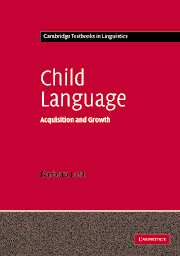Book contents
- Frontmatter
- Contents
- List of figures
- List of tables
- Preface
- Acknowledgements
- 1 The Growth of language
- 2 What is acquired?
- 3 What is the problem of language acquisition?
- 4 How we can construct a theory of language acquisition
- 5 Brain and language development
- 6 The nature of nurture
- 7 How can we tell what children know? Methods for the study of language acquisition
- 8 The acquisition of phonology
- 9 The acquisition of syntax
- 10 The acquisition of semantics
- 11 On the nature of language growth
- 12 Conclusions: toward an integrated theory of language acquisition
- Appendices
- 1 Developmental milestones in motor and language development (adapted from Lenneberg 1967)
- 2a Developmental milestones in infant speech perception
- 2b Examples of sound distinctions perceived by infants
- 3 Developmental milestones in infant speech production
- 4 Developmental milestones in infant syntax: perception
- 5 Developmental milestones in infant syntax: production
- 6 Developmental milestones in infant semantics
- 7 Abbreviations and notations
- Glossary
- References
- Author index
- Subject index
7 - How can we tell what children know? Methods for the study of language acquisition
Published online by Cambridge University Press: 05 June 2012
- Frontmatter
- Contents
- List of figures
- List of tables
- Preface
- Acknowledgements
- 1 The Growth of language
- 2 What is acquired?
- 3 What is the problem of language acquisition?
- 4 How we can construct a theory of language acquisition
- 5 Brain and language development
- 6 The nature of nurture
- 7 How can we tell what children know? Methods for the study of language acquisition
- 8 The acquisition of phonology
- 9 The acquisition of syntax
- 10 The acquisition of semantics
- 11 On the nature of language growth
- 12 Conclusions: toward an integrated theory of language acquisition
- Appendices
- 1 Developmental milestones in motor and language development (adapted from Lenneberg 1967)
- 2a Developmental milestones in infant speech perception
- 2b Examples of sound distinctions perceived by infants
- 3 Developmental milestones in infant speech production
- 4 Developmental milestones in infant syntax: perception
- 5 Developmental milestones in infant syntax: production
- 6 Developmental milestones in infant semantics
- 7 Abbreviations and notations
- Glossary
- References
- Author index
- Subject index
Summary
Introduction
We need to know what children know and don't know about the grammar for their language along the course of language development. How can we do so? We must enter, with a developmental perspective, the domain of psycholinguistics, the study of how the mind represents and processes language, based on behavioral studies of language use.
Knowing vs. doing
We need to assess what children know about language on the basis of how they use language, i.e., how they speak and understand language, or make metalinguistic judgments about it. However, when we observe a child speaking, interpreting or judging any particular utterance, this single behavior will never reveal the child's knowledge.
If Mary utters a sentence like (1a), Jessica may answer with (1b). We can't estimate Jessica's knowledge on the basis of her utterance in (1b) alone. If we did, we could mistakenly think that Jessica doesn't know how to inflect verbs for tense, or doesn't know that English requires overt subjects in sentences. Our data must expand beyond observations of single sentences.
1. a. Mary: What do you want to do now?
b. Jessica: Go home
We must also discover what children do not do in principle. If Jessica randomly produced not only (1b) but also (2) at other times, this would suggest that, for Jessica, word order was random. We need to know that (2) does not occur while (1b) does, in related contexts.
Information
- Type
- Chapter
- Information
- Child LanguageAcquisition and Growth, pp. 123 - 142Publisher: Cambridge University PressPrint publication year: 2006
